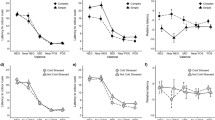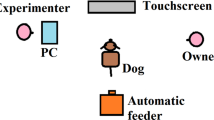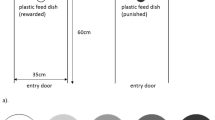Abstract
Negative affect in humans and animals is known to cause individuals to interpret ambiguous stimuli pessimistically, a phenomenon termed ‘cognitive bias’. Here, we used captive European starlings (Sturnus vulgaris) to test the hypothesis that a reduction in environmental conditions, from enriched to non-enriched cages, would engender negative affect, and hence ‘pessimistic’ biases. We also explored whether individual differences in stereotypic behaviour (repetitive somersaulting) predicted ‘pessimism’. Eight birds were trained on a novel conditional discrimination task with differential rewards, in which background shade (light or dark) determined which of two covered dishes contained a food reward. The reward was small when the background was light, but large when the background was dark. We then presented background shades intermediate between those trained to assess the birds’ bias to choose the dish associated with the smaller food reward (a ‘pessimistic’ judgement) when the discriminative stimulus was ambiguous. Contrary to predictions, changes in the level of cage enrichment had no effect on ‘pessimism’. However, changes in the latency to choose and probability of expressing a choice suggested that birds learnt rapidly that trials with ambiguous stimuli were unreinforced. Individual differences in performance of stereotypies did predict ‘pessimism’. Specifically, birds that somersaulted were more likely to choose the dish associated with the smaller food reward in the presence of the most ambiguous discriminative stimulus. We propose that somersaulting is part of a wider suite of behavioural traits indicative of a stress response to captive conditions that is symptomatic of a negative affective state.




Similar content being viewed by others
References
Asher L (2007) Welfare of captive European starlings (Sturnus vulgaris). Ph.D. Thesis. Institute of Neuroscience, Newcastle University, Newcastle upon Tyne
Asher L, Davies GTO, Bertenshaw CE, Cox MAA, Bateson M (2009) The effects of cage volume and cage shape on the condition and behaviour of captive European starlings (Sturnus vulgaris). Appl Anim Behav Sci 116:286–294
Bar-Haim Y, Lamy D, Pergamin L, Bakermans-Kranenburg MJ, van Ijendoorn MH (2007) Threat-related attentional bias in anxious and nonanxious individuals: a meta-analytic study. Psychol Bull 133:1–24
Bateson M, Kacelnik A (1995) Preferences for fixed and variables food sources–variability in amount and delay. J Exp Anal Behav 63:313–329
Bateson M, Matheson SM (2007) Performance on a categorisation task suggests that removal of environmental enrichment induces ‘pessimism’ in captive European starlings (Sturnus vulgaris). Anim Welfare 16:33–36
Bergvall UA, Rautio P, Luotola T, Leimar O (2007) A test of simultaneous and successive negative contrast in fallow deer foraging behaviour. Anim Behav 74:395–402
Blumstein DT, Evans CS, Daniel JC (2000) J Watcher 0.9. An introductory user’s guide
Brilot BO, Asher L, Feenders G, Bateson M (2009a) Quantification of abnormal repetitive behavior in captive European starlings (Sturnus vulgaris). Behav Process 82:256–264
Brilot BO, Normandale CL, Parkin A, Bateson M (2009b) Can we use starlings’ aversion to eyespots as the basis for a novel ‘cognitive bias’ task? Appl Anim Behav Sci 118:182–190
Burman OHP, Parker R, Paul ES, Mendl M (2008a) A spatial judgement task to determine background emotional state in laboratory rats, Rattus norvegicus. Anim Behav 76:801–809
Burman OHP, Parker RMA, Paul ES, Mendl M (2008b) Sensitivity to reward loss as an indicator of animal emotion and welfare. Biol Lett 4:330–333
Enkel T, Gholizadeh D, von Bohlen Und Halbach O, Sanchis-Segura C, Hurlemann R, Spanagel R, Gass P, Vollmayr B (2009) Ambiguous-cue interpretation is biased under stress- and depression-like states in rats. Neuropsychopharmacol. Advance online publication. doi: 10.1038/npp.2009.204
Eysenck MW, Mogg K, May J, Richards A, Mathews A (1991) Bias in interpretation of ambiguous sentences related to threat in anxiety. J Abnorm Psychol 100:144–150
Flaherty CF (1996) Incentive relativity. Cambridge University Press, Cambridge
Greenwood VJ, Smith EL, Goldsmith AR, Cuthill IC, Crisp LH, Walter-Swan MB, Bennett ATD (2004) Does the flicker frequency of fluorescent lighting affect the welfare of captive European starlings? Appl Anim Behav Sci 86:145–159
Harding EJ, Paul ES, Mendl M (2004) Animal behavior: cognitive bias and affective state. Nature 427:312
Maddocks SA, Goldsmith AR, Cuthill IC (2002) Behavioural and physiological effects of absence of ultraviolet wavelengths on European starlings Sturnus vulgaris. J Avian Biol 33:103–106
Mason G (2006) Stereotypic behaviour in captive animals: fundamentals and implications for welfare and beyond. In: Mason G, Rushen J (eds) Stereotypic animal behaviour: fundamentals and applications to welfare, 2nd edn. CABI, Wallingford, pp 325–356
Mason GJ, Latham NR (2004) Can’t stop, won’t stop: is stereotypy a reliable animal welfare indicator? Anim Welfare 13:S57–S69
Mason G, Rushen J (2006) Stereotypic animal behaviour: fundamentals and applications to welfare, 2nd edn. CABI, Wallingford
Matheson SM (2007) Using cognitive bias to assess welfare in captive European starlings (Sturnus vulgaris). M.Sc. Thesis. Institute of Neuroscience, Newcastle University, Newcastle upon Tyne
Matheson SM, Asher L, Bateson M (2008) Larger, enriched cages are associated with ‘optimistic’ response biases in captive European starlings (Sturnus vulgaris). Appl Anim Behav Sci 109:374–383
Mendl M (1999) Performing under pressure: stress and cognitive function. Appl Anim Behav Sci 65:221–244
Mendl M, Burman OHP, Parker RMA, Paul ES (2009) Cognitive bias as an indicator of animal emotion and welfare: emerging evidence and underlying mechanisms. Appl Anim Behav Sci 118:161–181
Okuda S, Roozendaal B, McGaugh JL (2004) Glucocorticoid effects on object recognition memory require training-associated emotional arousal. Proc Natl Acad Sci USA 101:853–858
Paul ES, Harding EJ, Mendl M (2005) Measuring emotional processes in animals: the utility of a cognitive approach. Neurosci Biobehav Rev 29:469–491
Rich EL, Romero LM (2005) Exposure to chronic stress downregulates corticosterone responses to acute stressors. Am J Physiol Regul Integr Comp Physiol 288:R1628–R1636
Williams JMG, Watts FN, MacLeod C, Matthews A (1997) Cognitive psychology and emotional disorders. Wiley, Chichester
Young RJ (2003) Environmental enrichment for captive animals. Blackwell Publishing, Oxford
Acknowledgments
We thank Michelle Waddle for technical help. We thank Jim Clapp, Domhnall Jennings, Stephanie Matheson, Mike Mendl, Jeroen Minderman, Liz Paul and several anonymous referees for help and advice. This work was supported by two grants awarded to MB from the UK’s Biotechnology and Biological Sciences Research Council (BB/E012000/1 and BB/05623/1).
Author information
Authors and Affiliations
Corresponding author
Rights and permissions
About this article
Cite this article
Brilot, B.O., Asher, L. & Bateson, M. Stereotyping starlings are more ‘pessimistic’. Anim Cogn 13, 721–731 (2010). https://doi.org/10.1007/s10071-010-0323-z
Received:
Revised:
Accepted:
Published:
Issue Date:
DOI: https://doi.org/10.1007/s10071-010-0323-z




